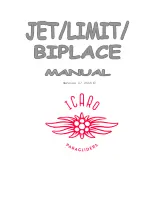
Nice Air Operation Procedure PA-34 Seneca
Copy Right Nice Air 2575 Robert Fowler Way, San Jose, CA 95148 Phone(408)729-3383
4
How can you make sure you have correct fuel?
Color. 100 is green. 100 LL is blue.
Landing gear
Type of the landing gear?
Tri-cycle, retractable.
How does it work?
It is electrical-hydraulic system. Pilot can select the position(up/down) by the gear handle. The electri
-
cal motor rotate the hydraulic pump which send the hydraulic fluid from reservoir to three actuators.
The fluid move the piston in each actuators to move the push-pull rod which are connected to the land
-
ing gears.
Each gear (Left, right main and the nose) has up limit and down limit switches When all three up
limit switches are pressed, red unsafe warning light will be off and pump will stop. Also, there is a
hydraulic pressure switch. When the gear is up and hydraulic pressure inside reaches certain amount,
it disconnect the circuit and the pump will stop. When the hydraulic pressure decrease, pressure switch
activate the motor to pump the hydraulic fluid. The pressure switch and the up limit switch is in the se
-
rial connection so either pressure reaches the set amount or all three up limit switches are pressed the
pump will stop.
When all three down limit switches are pressed, pump will stop and green lights are turned on.
Where is the power pack located?
In the nose baggage compartment.
What is the color of the hydraulic fluid?
Red.
What will happen in the case of loss of hydraulic fluid?
The gear will drop by gravity and spring.
How can you make sure it is down and locked?
Three green lights.
Is there anything to tell you the position of the nose gear?
There is a mirror on the left cowling to check nose gear position
Lock systems(up/down).
Up-No mechanical lock. Only supported by hydraulic pressure.
Down-Over center lock supported by spring and finger hook.
What is the maximum speed you can extend/retract the gear?
Vle is150 MPH. However, for retraction, it must be below 125 MPH.
Is there any system which warns you when you forget to extend the gear for a landing?
There is warning horn. When the throttle is reduced(14”) with gear up, it beeps. When the flap is ex
-
tended at 25 or 40 degree with gear up, it beeps. It beeps on the ground when the gear handle is up.
And gear unsafe light (red) illuminates if it not fully down or fully up.
What will happen if you move gear handle up while you taxi on the ground?



































